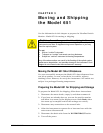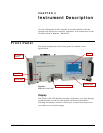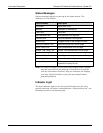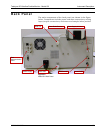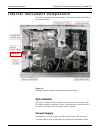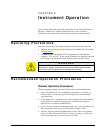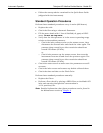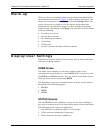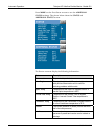
Instrument Description Teledyne API Ultrafine Particle Monitor - Model 651
40 07506C DCN6727
Data Communication Ports
USB Communication Port
The Model 651 provides a USB port for communications use.
RS-232 Serial Connections
The Model 651 provides one standard, 9-pin RS-232 serial port that
allows communication between a computer and the particle
monitor. Serial commands are sent to and from the computer to
monitor instrument status information, to retrieve and monitor
data, and to provide a variety of control functions such as turning
the pump on and off. More information can be found in the
Computer Interface
section of Chapter 8 in this manual.
Analog Input
The Model 651 can monitor the analog voltage from an external
source via the analog input BNC connector on the back panel
(labeled Analog Input). The input voltage range for these ports is
0 to 10 V. Analog voltages can be displayed together with
concentration data on the display screen and can be saved to the
removable Flash Drive or a computer. Voltages from connected
pressure, flow, or temperature transducers can be correlated to
particle concentration in real time.
Amplification must be supplied by the user to bring low voltage
signals to the appropriate 0 to 10 V range for best resolution.
DMA/Analog Out and Pulse Out
During normal operation of the Model 651, the Analog Out port
provides an analog 0 to 10 V signal proportional (linear or log) to
particle concentration. This particle concentration is corrected for
coincidence and tracks the displayed concentration.
Pulse Out provides a 5-volt (50-ohm termination) digital pulse for
each particle detected. This enables you to use your own counting
electronics hardware and provides a particle trigger for special
applications. The width of the pulse depends on both the shape of
the photo detector pulse and the trigger-level of the pulse threshold.
To provide accurate pulse counts, use a counter that is capable of
counting pulses with a width of 50 nanoseconds or less.
Particle concentrations that have been calculated based on the
particle counts from the counting electronics hardware are not live-
time corrected for particle coincidence. Thus, when particle
concentration is high, the concentration provided by this output
might be lower than the displayed concentration. Appropriate
coincidence correction should be applied when pulse output is used
for high concentration measurements.




